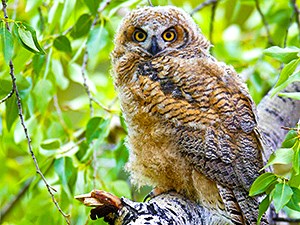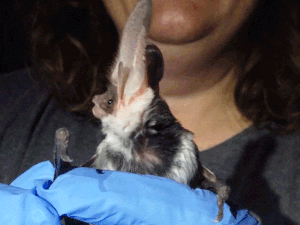

Image credit: NPS
From the Editor
The Art of Adapting
Innovating to help the most vulnerable. Outfoxing wildfires gone wild. Listening to people who know. Asking for help. Inspiring (and being inspired by) kids.
In Brief

Research | Wildlife Diseases
A New Treatment to Control Plague in Wildlife Shows Promise
Experiments with fipronil-laden prairie dog bait suggest the insecticide can be a powerful tool for reducing the "Black Death" in wildlife, especially if integrated with other methods.
By David Eads, Scott Carleton, Travis Livieri, Eddie Childers, Phil Dobesh, John Hughes, Paul Roghair, Angela Jarding, and Danielle Buttke
Image credit: NPS

Research | Coasts
How Worm Harvesters Are Helping Acadia Understand Its Declining Coastal Fisheries
Acadia National Park is working with local communities to study the park’s changing coastal environment. There’s a lot at stake.
By Hannah Webber and Abe Miller-Rushing
Image © Schoodic Institute / Hannah Webber
Picture This
The stories behind extraordinary images and videos from the practice of park science

An emerging filmmaker's captivating 60-second video about this reclusive animal’s motherly instincts.
Perspectives

Profiles | Marine Science
If Seaweed Could Talk
Renowned phycologist and marine ecologist Susan Brawley discovered that even the simplest organisms can teach us profound lessons.
By Olivia Milloway and Catherine Schmitt
Image © Schoodic Institute / Catherine Schmitt

Research | Social Science
Employee Surveys Give Clues to Reducing Tick-Borne Disease
Two studies show the value of standardized procedures, in-person training, and site-specific information.
By Stefanie Bolas and Maria Said
Image credit: Centers for Disease Control and Prevention

Technology | Innovations
Remote Audio-Recording Devices Hear Birds When We Can’t
New technology makes it possible to record hundreds of thousands of songs in a short time. That could make protecting wild birds and other at-risk animals easier.
By Megan Tomerlin
Image credit: NPS / Jim Peaco
Features

Community Science
When Communities Lead the Way
Community (led) science takes scientific research outside park boundaries and into people’s lives. The effects can be transformational.
By Tim Watkins, Claudia Santiago, Ashley Pipkin, and Abe Miller-Rushing
Image courtesy of Tammy Binder

Forests
Coming Full Circle: How Parks Are Using Conventional Tools in New Ways to Restore Imperiled Forests
Depriving western old-growth forests of fire brought them to the brink. Now the fire they need also threatens them. To fix this, parks are returning to mechanical forestry methods.
By Jennifer Gibson, Leonel Arguello, Anthony Caprio, Garrett Dickman, Eamon Engber, Eric Knapp, and Jason Teraoka
Image credit: NPS / G. Dickman

Bats
Bats Are in Danger. Here’s How and Why We’re Helping Them.
Bats are amazing animals and a formidable force against insect pests, but a nasty fungal disease is killing them. A coordinated national response brings hope.
By Michelle Verant, Bik Wheeler, Mark Ford, Ian Abernethy, Rob Schorr, Allen Calvert, Bryan Hamilton, and Kimber Godfrey
Image credit: NPS / Bryan Hamilton

Sea Turtles
Despite Heroic Efforts, Kemp’s Ridley Sea Turtles Remain Critically Endangered
A seashore’s extraordinary work to rescue Kemp’s ridley sea turtles from extinction is holding the line for this ancient species. But their numbers are still too low to reclassify them as “threatened.”
By Hilary Frandsen
Image credit: NPS

Citizen Science
Let Me Count the Ways: How Citizen Scientists Helped a Park Measure Visitor Impacts
Wildly popular Rocky Mountain National Park wanted to measure the extent of resource damage from all that love. It needed the help of some ardent supporters.
By Paige Lambert, Scott Esser, Koren Nydick, and Varun Kirk Acharya
Image credit: NPS

Water Quality
Wildland Fires Could Be Putting Your Drinking Water at Risk
Hotter and more frequent wildfires are threatening water sources in the West. We looked at what the latest research says about protecting them.
By Michael Wandersee, Dara Zimmerman, Kelly Kachurak, Leo Angelo Gumapas, Kayla DeVault Wendt, and Kurt Kesteloot
Image credit: NPS / Heather Davies
Educate & Interpret

Citizen Science | Biological Controls
Making Environmental STEM Education Stick
A citizen science project tests whether a small wasp can restore native habitat. It also shows the benefits of firsthand experience for high school students.
By M. Nikki Grant-Hoffman and Anjelica Spencer
Image courtesy of Colorado Canyons Association

Environmental Ed | Title-1
A Visit of a Lifetime
The White House and President’s Park’s environmental educational program gives Title-1 students a chance to learn how much they’re capable of.
By Alyssa Chiascione and Kathy Langley
Image credit: NPS / Grace Anderson
About This Issue
Last updated: February 7, 2025
